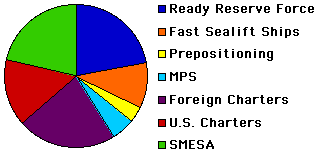Merchant Marine and Civilian Mariners in 1990-1991 Persian Gulf War
Desert Shield and Desert Storm
On July 17, 1990, Saddam Hussein accused Kuwait and the United Arab Emirates of overproduction of oil, thereby flooding the world market and decreasing its income from its sole export. Talks between Iraq and Kuwait collapsed on August 1, 1990. On August 2, Iraqi with a population of 21 million invaded its little neighbor Kuwait, which had a population of less than two million.
Much of the world expressed outrage at the reported abuses of human rights by the conquerors of Kuwait. The United States immediately claimed concern about our suffering brothers in Kuwait and U. S. interests.
A few days later Iraqi troops massed along the Saudi Arabian border in position for attack. Saudi Arabia asked the United States for help.
In spite of severe economic sanctions, countless United Nations resolutions, and diplomatic measures, Iraq refused to withdraw from Kuwait. During the early hours of January 17th, about 27 hours after the expiration of the United Nations deadline for withdrawal of Iraqi forces from Kuwait, U. S. warplanes began a bombing campaign against strategic targets in Iraq. Desert Shield -- U.S. protection of other Allies in the region -- was officially over. Desert Storm had begun.
One month later, on the night of February 23, U. S. warships bombarded the coastline of Kuwait, as if softening up the area for an amphibious landing. Fighters from several aircraft carriers in the Persian Gulf launched coordinated air strikes. Meanwhile Allied land forces, comprising hundreds of Abrams M-1 tanks and Bradley armored vehicles, drove across 200 miles of brand-new highway across the Saudi Arabian desert to attack Iraq.
The "100 Hour War" would destroy the vaunted Iraqi Republican Army, 500,000 strong.
Why the six-month delay in liberating the citizens of Kuwait and defending our interests -- i.e. protecting one of our major oil suppliers? A large part of the answer is supply.
Every general knows tactics and logistics are intertwined in planning a military campaign. Hannibal used elephants to carry his supplies across the Alps during his invasion of the Roman Empire. George Washington's colonial militias had only nine rounds of gunpowder per man at the start of the Revolution, but American privateers brought in 2 million pounds of gunpowder and saltpeter in just one year.
Dwight Eisenhower's plans for the June 1944 invasion of Normandy hinged on a massive build-up of war materiel in England and the "Mulberry" artificial harbors which allowed for unloading reinforcements and supplies. The most brilliant tactics are doomed without the ability to get the manpower and supplies in the right place at the right time.
The six month Gulf War buildup involved four times as much supply as the Normandy Invasion.
Television broadcasts, probably aimed at intimidating Saddam Hussein, showed C-5 cargo jets, the largest in the world at the time, landing every 10 minutes at staging areas. What television didn't show were the chartered merchant marine and Military Sealift command cargo ships docking at three Arabian ports. One Roll-On/roll-Off cargo ship could carry 1,000 combat-ready Abrams tanks, while the C-5 could carry two at most. [The M1-A1 Abrams Tank is 32 feet 3 inches long; 12 feet wide; 8 feet high; 120,250 lbs combat loaded.]
Military personnel traveled on chartered planes, but their gear traveled by ship. Ships transported 3.5 million tons of cargo (95% of total), and seven million tons of fuel (99% of total) to the Persian Gulf from August 1990 until March 1991.
United States forces deployed
7 Army Divisions
2 Marine Corps Divisions
6 Carrier Battle Groups
2 Amphibious Battle Groups
1 Marine Air Wing
15 Air Force Tactical Fighter Wings
Misc. attached unitsThese forces required over 112,500 vehicles including 3,500 tanks, 2,200 armored vehicles, and 1,000 helicopters. The shipment of supplies to the Persian Gulf averaged 4,800 tons per day during this deployment.
Activation of Ships for Operation Desert Shield
Military Sealift Command activated Maritime Prepositioning Ships, Afloat Prepositioning Ships, and Fast Sealift Ships on August 7, 1990 for Operation Desert Shield.
Each of the three Maritime Prepositioning Squadrons contained all the equipment to support a 16,500 person Marine Expeditionary Brigade for 30 days. The ships transported the prepositioned cargo and Military Airlift Command flew in the troops and supplemental equipment. It took 259 flights to transport the 7th Marine Expeditionary Brigade from Twenty-nine Palms, CA to Saudi Arabia.
Maritime Prepositioning Ships are unique ships: part tanker, part container ship and part Roll-On/Roll-Off, can unload without assistance from the shore. The ships are commercially owned and operated under an exclusive twenty-five year contract to the Navy.
Desert Shield and Desert Storm Strategic Sealift of Dry Cargo (to March 10, 1991)
